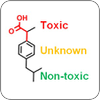
RESEARCH
PREDICTIVE ADMET MODELING

We develop in silico models, which enable rapid high-throughput screening for different Adsorption, Distribution, Metabolism, Excretion, and Toxicity (ADMET) assay endpoints, and are thereby suitable for pre-clinical evaluation of drugs and countermeasures. To enable prioritization of drug candidates, we develop computational tools, for example, which rapidly screen compounds to assess AMES mutagenicity, hERG for cardiac toxicities, drug efflux via P-glycoproteins, and drug metabolism via cytochrome P450 enzymes.
Software
Publications
Dey, S., A. Wallqvist, and M. D. M. AbdulHameed. Developing muscarinic receptor M1 classification models utilizing transfer learning and generative AI techniques. Scientific Reports. 2025 May 12; 15:16486. [PDF, Pubmed]
AbdulHameed, M. D. M., S. Dey, Z. Xu, B. Clancy, V. Desai, and A. Wallqvist. MONSTROUS: a web-based chemical-transporter interaction profiler. Frontiers in Pharmacology. 2025 February 26; 16:1498945. [PDF, Pubmed]
Liu, R., M. D. M. AbdulHameed, Z. Xu, B. Clancy, V. Desai, and A. Wallqvist. Rapid screening of chemicals for their potential to cause specific toxidromes. Frontiers in Drug Discovery. 2024 February 5; 4:1324564. [PDF, Link]
AbdulHameed, M. D. M., R. Liu, and A. Wallqvist. Using a graph convolutional neural network model to identify bile salt export pump inhibitors. ACS Omega. 2023 June 6; 8:21853-21861. [PDF, Pubmed]
Liu, R., S. Laxminarayan, J. Reifman, and A. Wallqvist. Enabling data-limited chemical bioactivity predictions through deep neural network transfer learning. Journal of Computer-Aided Molecular Design. 2022 December 1; 36(12):867-878. [PDF, Pubmed]
AbdulHameed, M. D., R. Liu, P. Schyman, D. Sachs, Z. Xu, V. Desai, and A. Wallqvist. ToxProfiler: toxicity-target profiler based on chemical similarity. Computational Toxicology. 2021 May; 18:100162. [PDF, Link]
Schyman, P., R. L. Printz, S. K. Estes, T. P. O'Brien, M. Shiota, and A. Wallqvist. Concordance between thioacetamide-induced liver injury in rat and human in vitro gene expression data. International Journal of Molecular Sciences. 2020 June 4; 21(11):4017. [PDF, PubMed]
Schyman, P., R. L. Printz, S. K. Estes, T. P. O’Brien, M. Shiota, and A. Wallqvist. Assessing chemical-induced liver injury in vivo from in vitro gene expression data in the rat: the case of thioacetamide toxicity. Frontiers in Genetics. 2019 November 26; 10:1233. [PDF, PubMed]
Liu, R., M. D. M. AbdulHameed, and A. Wallqvist. Teaching an old dog new tricks: strategies that improve early recognition in similarity-based virtual screening. Frontiers in Chemistry. 2019 October 23; 7:701. [PDF, PubMed]
Wang, H., R. Liu, P. Schyman, and A. Wallqvist. Deep neural network models for predicting chemically induced liver toxicity endpoints from transcriptomic responses. Frontiers in Pharmacology. 2019 February 5; 10:42. [PDF, PubMed]
Liu, R., H. Wang, K. P. Glover, M. G. Feasel, and A. Wallqvist. Dissecting machine-learning prediction of molecular activity: is an applicability domain needed for quantitative structure-activity relationship models based on deep neural networks? Journal of Chemical Information and Modeling. 2019 January 28; 59(1):117-126. [PDF, PubMed]
Liu, R., and A. Wallqvist. Molecular similarity-based domain applicability metric efficiently identifies out-of-domain compounds. Journal of Chemical Information and Modeling. 2019 January 28; 59(1):181-189. [PDF, PubMed]
Liu, R., K. P. Glover, M. G. Feasel, and A. Wallqvist. General approach to estimate error bars for quantitative structure-activity relationship predictions of molecular activity. Journal of Chemical Information and Modeling. 2018 August 27; 58(8):1561-1575. [PDF, PubMed]
Liu, R., M. Madore, K. P. Glover, M. G. Feasel, and A. Wallqvist. Assessing deep and shallow learning methods for quantitative prediction of acute chemical toxicity. Toxicological Sciences. 2018 August 1; 164(2):512-526. [PDF, PubMed]
Schyman, P., R. Liu, V. Desai, and A. Wallqvist. vNN web server for ADMET predictions. Frontiers in Pharmacology. 2017 December 4; 8:889. [PDF, PubMed]
Liu, R., M. D. M. AbdulHameed, and A. Wallqvist. Molecular structure-based large-scale prediction of chemical-induced gene expression changes. Journal of Chemical Information and Modeling. 2017 September 25; 57(9):2194-2202. [PDF, PubMed]
Schyman, P., R. Liu, and A. Wallqvist. Using the variable-nearest neighbor method to identify P-glycoprotein substrates and inhibitors. ACS Omega. 2016 November 16; 1(5):923-929. [PDF, PubMed]
Schyman, P., R. Liu, and A. Wallqvist. General purpose 2D and 3D similarity approach to identify hERG blockers. Journal of Chemical Information and Modeling. 2016 January 25; 56(1):213-222. [PDF, PubMed]
Liu, R., X. Yu, and A. Wallqvist. Data-driven identification of structural alerts for mitigating the risk of drug-induced human liver injuries. Journal of Cheminformatics. 2015 February 11; 7:4. [PDF, PubMed]
Liu, R., P. Schyman, and A. Wallqvist. Critically assessing the predictive power of QSAR models for human liver microsomal stability. Journal of Chemical Information and Modeling. 2015; 55(8):1566-1575. [PDF, PubMed]
Liu, R., and A. Wallqvist. Merging applicability domains for in silico assessment of chemical mutagenicity. Journal of Chemical Information and Modeling. 2014 March 24; 54(3):793-800. [PDF, PubMed]
Singh, N., S. Chaudhury, R. Liu, M. D. AbdulHameed, G. Tawa, and A. Wallqvist. QSAR classification model for antibacterial compounds and its use in virtual screening. Journal of Chemical Information and Modeling. 2012 October 22; 52(10):2559-2569. [PDF, PubMed]
Liu, R., G. Tawa, and A. Wallqvist. Locally weighted learning methods for predicting dose-dependent toxicity with application to the human maximum recommended daily dose. Chemical Research in Toxicology. 2012 October 15; 25(10):2216-2226. [PDF, PubMed]
Peach, M. L., A. V. Zakharov, R. Liu, A. Pugliese, G. Tawa, A. Wallqvist, and M. C. Nicklaus. Computational tools and resources for metabolism-related property predictions. 1. Overview of publicly available (free and commercial) databases and software. Future Medicinal Chemistry. 2012 October; 4(15):1907-1932. [PDF, PubMed]
Liu, R., J. Liu, G. Tawa, and A. Wallqvist. 2D SMARTCyp reactivity-based site of metabolism prediction for major drug-metabolizing cytochrome P450 enzymes. Journal of Chemical Information and Modeling. 2012 June 25; 52(6):1698-1712. [PDF, PubMed]
AbdulHameed, M. D., S. Chaudhury, N. Singh, H. Sun, A. Wallqvist, and G. J. Tawa. Exploring polypharmacology using a ROCS-based target fishing approach. Journal of Chemical Information and Modeling. 2012 February 27; 52(2):492-505. [PDF, PubMed]